
ENGINEERING REPORT 2011
From the January 2012 4150 Newsletter.
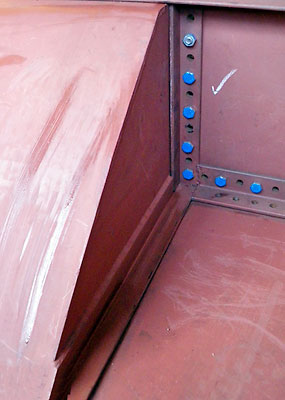
The welded 'box' seen in part on the left covers the sloping section of the loco mainframes, where they drop from footplate level to bunker base level.
Work during the last twelve months has concentrated on construction of the new bunker, as this and the tanks are probably the biggest challenge we have to meet before we can consider pushing for a slot in the boiler shop. The principle remains to rivet everything where rivets are visible, but to weld as much of the internal structure as possible in the interests of speed and economy. We are too close to houses at Bewdley to consider riveting on a large scale, so we are drilling all of the steel sheets and the substantial internal 'skeleton' of heavy angle to which they are attached, and then bolting everything together until the entire bunker can be taken up to Bridgnorth for riveting in the boiler shop. The clearance holes for 1/2" and 3/8" rivets are 9/16" and 13/32" respectively, and it so happens that 14mm and 10mm metric bolts are an almost perfect fit for the clearance holes, keeping the various components securely in their correct positions with a minimum of scope for unwanted movement. They're also cheap (!), but we have to ensure that none end up staying anywhere on the loco in the long run - Whitworth nuts and bolts are the Swindon norm, and Bridgnorth would rightly get upset if anything else found its way onto the engine. Hence the blue paint adorning every metric nut and bolt, the cause of much admiring comment but I'm afraid they're only temporary! Alternate holes are bolted, and when rivets are eventually put into the intermediate holes, the bolts will be removed for those holes also to be riveted.
A glance at a photo of a 41xx bunker will demonstrate just how many holes there are to be drilled, each of them going through between 13mm and 26mm of steel. We still haven't had time to count them, but one of these days........... An impressive spectacle at this time of year is to see the bunker from the outside when we've got a light set up inside it - something akin to a demented pepper pot, and certainly an acid test for confirming that all the holes are in line! Much of the drilling has been done by Terry Howes, who has a knack for inventing things and found time to design and construct a jig for drilling holes in angle or strip at predetermined centres in a perfect straight line. This will really come into its own on the tanks, where virtually all the steel we use will be brand new - no need to line up with old oval and irregular holes in wavy lines, as we initially did on the bunker. A lot of time was spent last year sorting out the large (and heavy) sheet which forms the upper part of the back of the bunker. This is 7ft wide, and has two opposing radiuses built in, so was always going to be a challenge. Too wide for our supplier's rollers, it had to be made in two sections, and unfortunately the rolling of the difficult smaller radius wasn't quite the same on the two sheets. So we ended up having to cut the two sheets into four before welding them back together again, with much welding, cutting and grinding in between. This sheet is still positioned temporarily on the old bunker, but we are anxious to get it in place on the new one as soon as possible to confirm it's a good fit. We are conscious at all times that we're dealing with a water vessel which has to not leak, so accuracy of fit is something of a mantra. Lucky the people constructing bunkers for pannier tanks and small prairies, which contain nothing but coal!
Progress on the bunker was also slowed by a change of strategy during the summer, brought about by an inspection by Ian Walker and Duncan Ballard, Bridgnorth Production Manager and Boiler Shop Contracts Manager respectively, of the work completed so far. As they were both in Bewdley for an SVR meeting, we asked if they would have a look at 4150, specifically to review what we were doing on the new bunker.
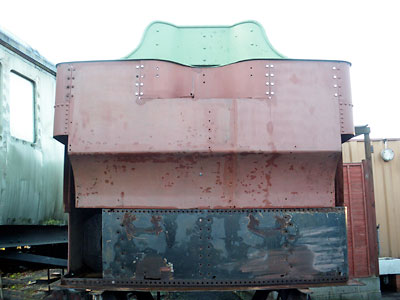
Upper section of the rear of the bunker, positioned temporarily on the old bunker. Note that the bottom halves of the old corner sheets have been carefully cut out.
They were happy with all of the new structure as fitted onto the frames of the loco, but were far from happy with the plan to cut out and re-use the back corner sheets and upper coal plate from the old bunker, along with the angles forming their supporting framework (our plan had been to lift these out in one piece by crane, and with the loco positioned alongside, drop them into place and line them up with holes already drilled in the new structure). Ian and Duncan pointed out various areas where the old plate was wasted, and numerous elongated rivet holes and areas of pitting in the old angles which might cause potential water leaks. At first this seemed a setback, as we'd been approaching the point where we could merge the two halves together and finish the bunker off, but on reflection the end result should be significantly better if everything in it is new, even though completion has been delayed by several months. Bridgnorth may have been influenced by their experience with 1501, which had entered traffic in the late 1990s with its bunker containing a mixture of old steel and new, but corrosion in the re-used old platework has led to a decision to replace the entire bunker during the loco's current overhaul.
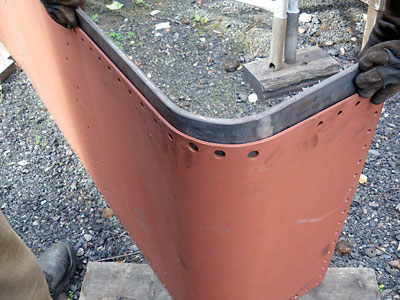
Checking the radius of the butt strip linking upper and lower rear sheets.
On the positive side, we will at least now avoid what would have been a very tense hour or two trying to line up rows of holes in two very large structures which have been drilled independently, and one of which would be dangling from a crane. However careful the drilling, this would have been a lot to ask, and could be regarded as a nightmare avoided! Progressing one sheet or angle at a time is a lot easier on the nerves. Something else we would have needed is a major shunt involving much of Bewdley yard, in order to get the loco positioned alongside the old bunker - another nightmare avoided! We do though now have the problem of fabricating the awkward corner sheets at the top of the back of the bunker, but we've cut out the really difficult multi-radiused corners at the centre of these sheets from the old bunker, and found them to be in excellent condition - the corrosion about which Bridgnorth were so concerned is around the edges of the old sheets, where they meet the angles and flat strips to which they are attached. This is a similar phenomenon to the grooving which causes a lot of problems along the lap joints in boilers and fireboxes. We have the option of either welding the central section of the old corners into an outer 'frame' of new sheet - another challenge for our ace welder Bob Russell - or having new corner sheets made complete, which Bridgnorth works are planning to do shortly for 1501.
One consequence of creating a new framework for the back half of the bunker is that we've had to develop a technique for bending hefty angle and flat strip to follow the curvature of the various sheets they relate to. In the case of angle, this involves cutting out a calculated length of one 'web' of the angle and using a great deal of heat to bend the other web round a solid steel former of the right radius. A new section of curved web is then welded into the gap left by the piece that was cut out. This sounds a bit 'agricultural', but has turned out to be quite successful, even on the massive 100x60x10mm angle which forms the inner perimeter of the bunker base. Final tweaking of some of these radiuses will have to await the arrival of the coal plate, in order to ensure there are absolutely no air (and hence water) gaps between sheet and angle.
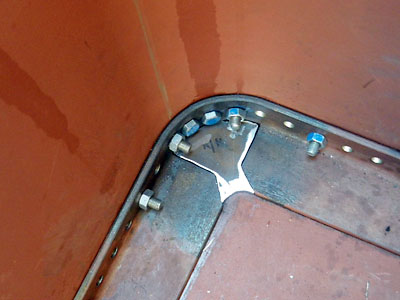
The large angle round the inner perimeter of the bunker base, with insert to be welded in.
To sum up the position on the bunker, the front half is completely finished and drilled ready for riveting, as is the entire base (apart from two welded inserts in the inside angle) and the bottom half of the back. New top corner sheets have been rolled and fitted, but need modification to incorporate the old corners. The new upper central sheet is complete but needs drilling (this is imminent), and everything above that is complete. The two transverse baffles and their associated angles are complete, as is the longitudinal one except where it joins the coal plate. The coal plate, which separates the coal space from the water space, is in fact the only part of the new bunker still missing - at 8mm it is too thick for our previous supplier to roll and guillotine, so we will shortly be approaching firms in the Black Country capable of taking the work on. We've set ourselves a target of having the bunker completed ready for riveting and final welding in time for the Behind the Scenes weekend in July, after which we'll start ordering steel for the tanks.
As was the case last year, work on the bunker has diverted Dave Link from the job of fabricating the 'crinolines' - the steel framework to which the boiler cladding will be attached. We have, though, been given the crinolines which were made at Bridgnorth for 2857 but were not, in the end, used on the loco. We are optimistic that they can be used on 4150 with a certain amount of modification, which would save us a lot of time and effort. They were retrieved from Bridgnorth after Christmas on one of the last trains operating before services were suspended for engineering work.
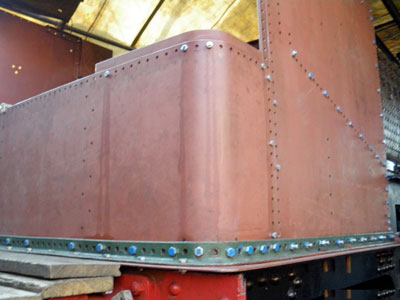
Preparing to fit the upper rear sheets, with the bottom angles now fully drilled.
Steve Morgan has been smartening up the backhead cladding sheets (which fit on the back of the firebox in the cab, behind the cab fittings). There are a dozen or so sheets altogether, made in different shapes and sizes to accommodate the various cab fittings and their mounting points, so the end result is something of a jigsaw puzzle. They are thicker gauge than the rest of the boiler and firebox cladding, so they have suffered minimal corrosion and can all be re-used, much improved in appearance now with their new paint. Also being painted by Steve at present are the flat cladding sheets at the front and back of the cylinder casting, made during the year by Alan Atkinson. Although these sheets are flat, several of their edges are radiused to fit the casting, requiring much use of our new jigsaw and a lot of filing to shape. We will be pleased to get these fitted on the loco, along with their associated heat-retentive lagging, as once they are in place we can re-fit the refurbished front sand boxes and free up some valuable space in the container. Alan is currently tackling the more difficult pieces of cladding which go over the valve end covers and are shaped rather like a meat dish.
Having finished the new steam heat pipework under the loco, Paul Mason has moved on to the vacuum pipe and completed about half so far, before his daughter's wedding caused a temporary halt to progress. Paul has been able to salvage the flanges from the old vacuum pipe, as they are in excellent condition and able to be skimmed for re-use with minimal loss of thickness.
We are grateful to Terry Jenkins of the Erlestoke Manor Fund for renewing and machining (at home) the driver's and fireman's seat pivots, which had worn distinctly oval, and to Dave Kilner for replacing a number of rotten planks in both ends of our Fruit D - the old ones were letting in rather too much wind and rain!